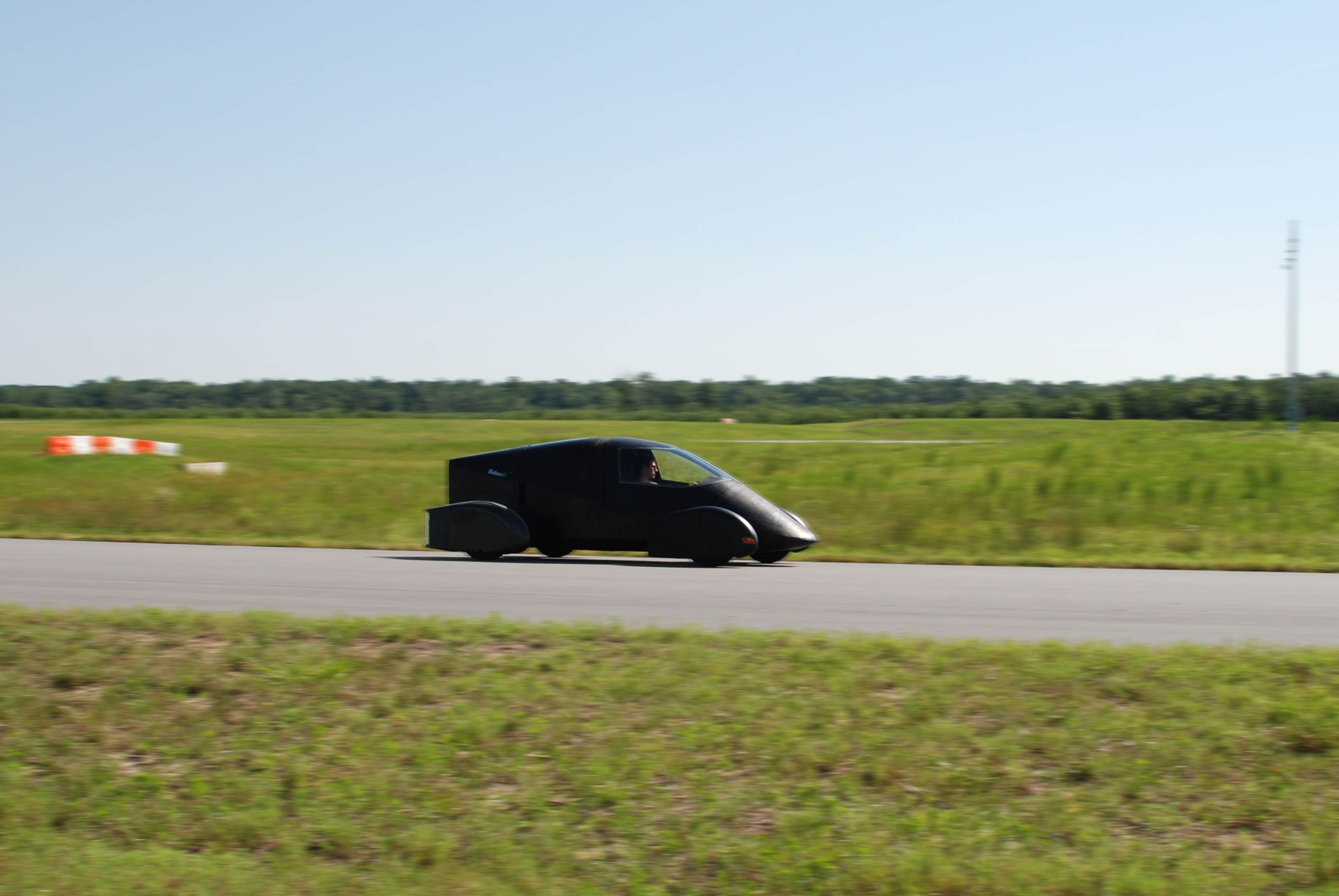The Limits of the Possible
We have been hinting for quite a while about an electric version of our Very Light Car, and how superb platform efficiency could solve electric car issues of range, battery weight and battery cost. We now have an electric prototype and last week spent a day at the North Carolina Center for Automotive Research (NCCAR) in Garysburg, NC, doing some initial testing. We are quite excited about the results and hope you will be too.

We emphasize that this is initial testing. These are own measurements, using our own equipment; we’ve checked them very thoroughly against each other and against our large and growing efficiency and performance database, and they are consistent and in line with our expectations. But until we’ve checked them with a certified test in an EPA approved lab, they’re provisional.
Edison2’s 4-seat electric car ran 45 laps of a 2.03 mile track in 2 hours, 6 minutes and 42 seconds. After this, our meter upstream of the charger showed it took 9.89 kWh to recharge. The empty car weighed 1031lb.

We are just listing our results and refraining from making any claims about this performance for a number of reasons. Although we ran the track in both directions, we’re not certain of the effect of the wind, or the impact of the approximately 1400 degrees of corners in each lap at NCCAR (but our calculations show the corners cost us about 13%).
But a big reason is that there are just too many unsubstantiated or misleading assertions about efficiency in today’s automotive world. The Nissan leaf advertised 367 MPG before the EPA tested the car and found a much more modest 99 MPGe. The VW diesel hybrid XL1 concept is rated at 313 MPG – but it turns out that is imperial gallons, which translates to 260 MPG US, but more importantly is calculated using NEDC (New European Driving Cycle) methodology, which does not take into account the energy from the battery; including the battery brings this down to 118 MPG (US) or 101.6 MPGe.
So soon we’ll be in the emissions lab, not to measure emissions but because that’s where the EPA measures the energy consumption reflected in MPG and MPGe on a new car’s window sticker. Labs are windless places and the tests are run in a straight line. We’ll let you know how we do.




 Wednesday, July 20, 2011 at 07:58AM
Wednesday, July 20, 2011 at 07:58AM
Reader Comments (9)
Hello,
This is great to hear. If my math is correct, your run on the track used an average of ~108.3Wh/mile which is very, very good; and almost exactly what some folks had predicted based on the E85 fueled VLC's. The Leaf is rated by the EPA at 340Wh/mile, but many people have driven it at under 200Wh/mile.
The Illuminati Motor Works 7 was tested at Chrysler Proving grounds at 155Wh/mile, which is also a great achievement; especially considering that the current weight of 7 is ~2,900 pounds.
Sincerely, Neil
This info is very interesting. I didn't know previously how mpg's were actually calculated. It's so easy to manipulate data & I appreciate that you guys don't. Makes you that much more credible. Appreciate your integrity.
By the way -- do I detect a new profile on the VLC in the article picture? It is a little more "cab forward" and the windshield and the nose form a smooth arc -- I like it!
Neil
So, 9.89 kWh for 91.35 miles at 33.7 kWh/gal equivalent comes out to 311 MPGe - nice!
At 1031 pounds the new electric VLC is less than a third the weight of the Leaf, and evidently will require only a 12 kWh battery to exceed the range of the Leaf with its 24 kWh battery. And this is just the first prototype electric VLC. 1031 pounds is not much heavier than the original VLC so I imagine the electric still has excellent handling and braking characteristics. We will be looking forward to EPA test results and more detailed descriptions of the electric.
Everyone will want a great handling low maintenance car that drives 100 miles on a dollar of electricity, especially if it is priced much less.than other EVs.
If you compare the consumption of the Edison2 VLC electric with the Illuminati Motor Works 7 (108Wh/mile vs 155Wh/mile) I think they are more proportional to the aerodynamic drag than to weight. I don't know the CdA of both cars, but the Cd is 0.16 vs 0.23 (if I recall correctly); while weight is 1031 vs 2900 pounds.
Aerodynamic drag is a total loss and it is a huge proportion of the force on the car. Weight is a penalty when you accelerate, but electric motors are still very efficient under acceleration, so that penalty is less for an electric drivetrain, I think. Also, the greater kinetic energy can be partially "returned" by both free wheel coasting (which is easier to do in an EV since they do not idle) and by regenerative braking.
Sincerely, Neil
Interesting car. Very good aerodynamics and light wheigt.
I only can see one image of the eVLC
I'm shocked at the huge difference between the mpg that car makers claim and the actual figure, especially with the Nissan Leaf. One has to wonder if the false numbers are just a ploy to lure in buyers.
electric motor rewinds
Dexter,
What claims are you referring to?
Oh, and your signature seems to have a Spam link in it...
Neil